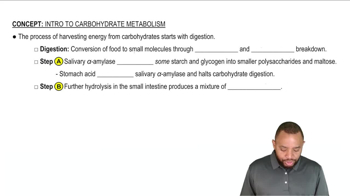Textbook Question
Identify the type of food as carbohydrate, fat, or protein that gives each of the following digestion products:
d. glycerol
 Verified step by step guidance
Verified step by step guidance Verified video answer for a similar problem:
Verified video answer for a similar problem:


 2:54m
2:54mMaster Intro to Lipid Digestion Concept 1 with a bite sized video explanation from Jules
Start learning